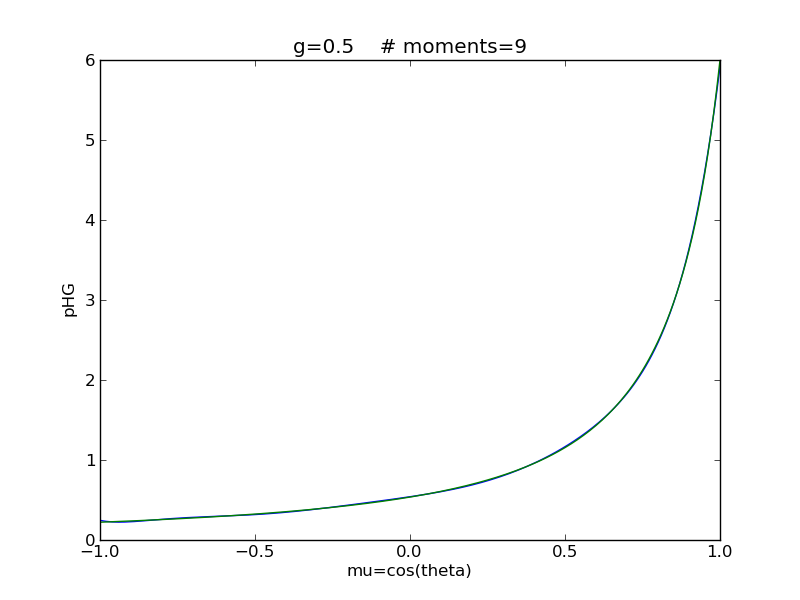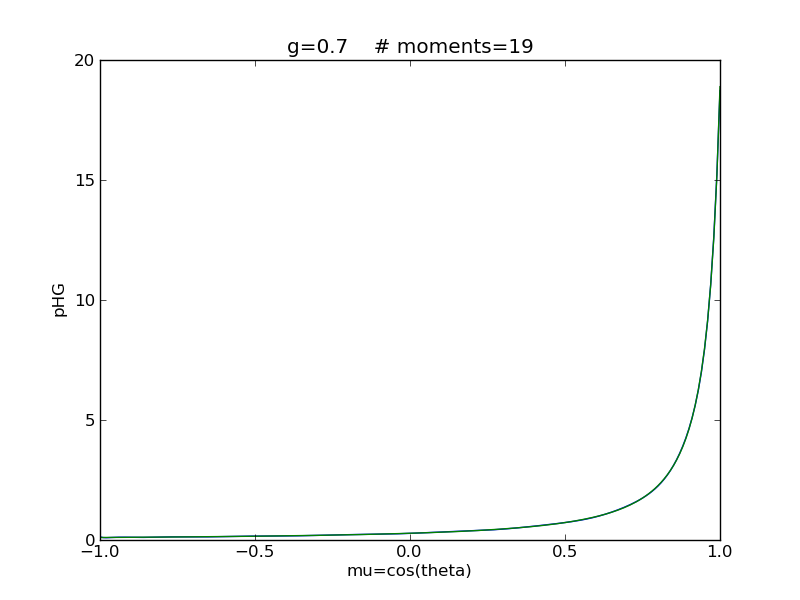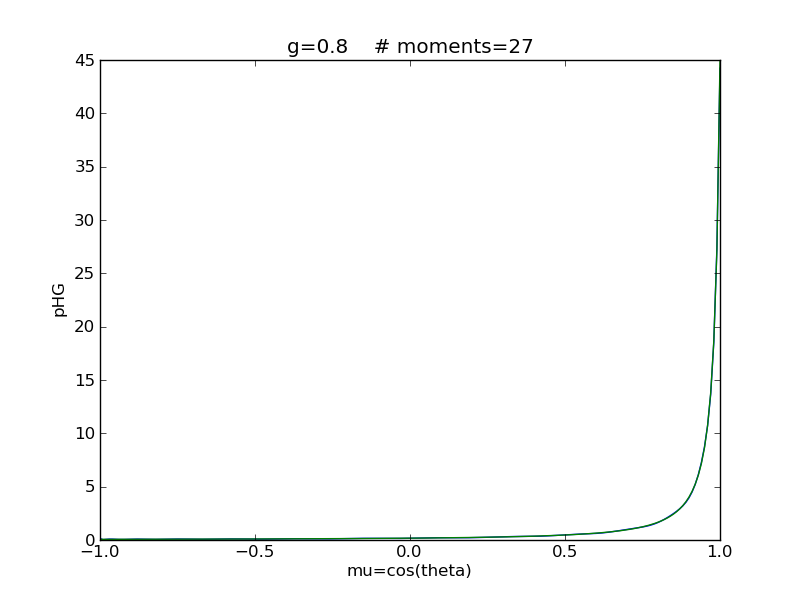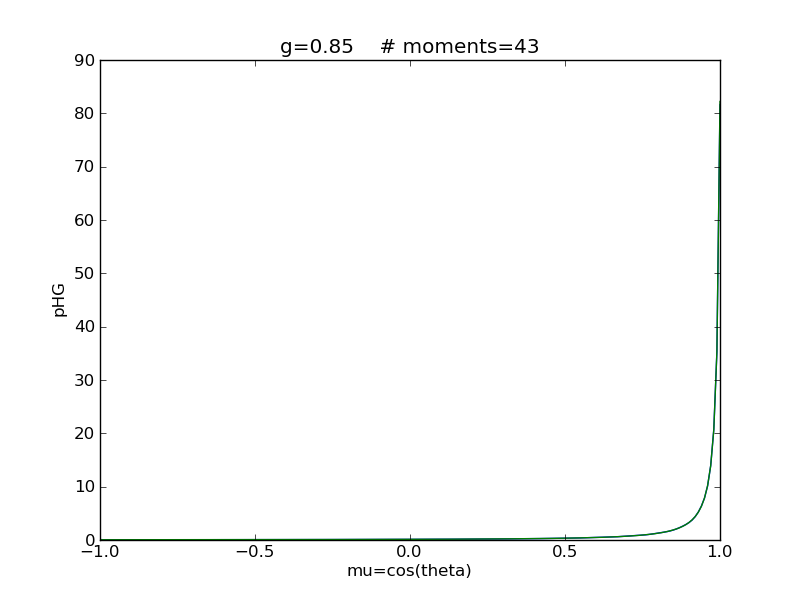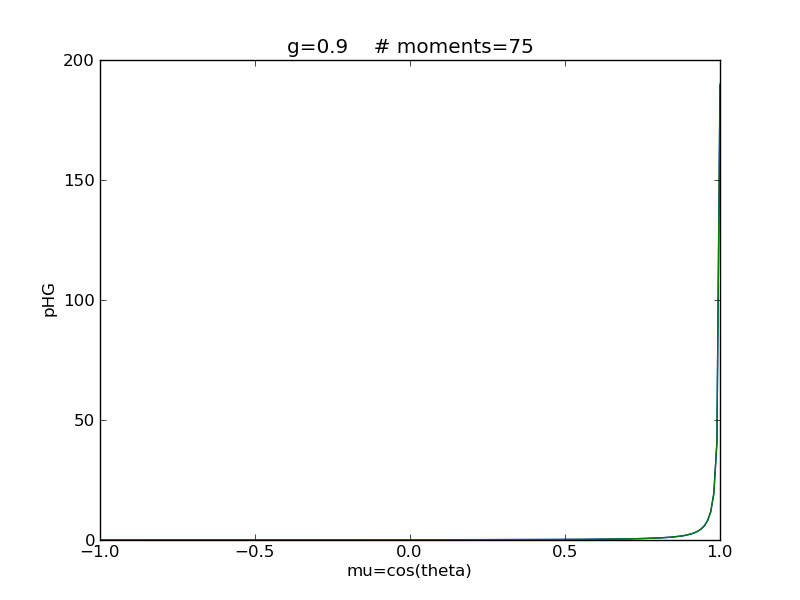Sidebar
Legendre decomposition of Heney Greenstein phase function
The Heney-Greenstein function p_HG=(1-g*g)/(1+g*g-2*g*mu)**(3/2) is often used to approximate scattering phase functions of aerosols or clouds. Show that the Legendre coefficients of p_HG are P_l=g^l. Investigate how many Legendre coefficients are required for asymmetry parameters of 0, 0.5, 0.7, 0.8, 0.85, 0.9.
Hint: Use the tool phase, which can be found in libRadtran/bin to calculate the phase function from the Legendre polynomials. Help is obtained by
phase -h
solution (Daniel, Benjamin, Florian)
We decided to use a graphical investigation of the problem. We need to find the number of required Legendre coefficients so that the two curves of P_HG and P_l converge. For this we write a shell script in combination with a python plot routine. Afterwards we look at the output to decide which number of Legendre coefficients is sufficient for individual asymmetry parameters.
Shell script:
- rte_heneygreenstein.sh
#!/bin/sh -f # shell skript libradtran_path='/local/libRadtran-1.5-beta/bin/' tmp_path='/home/users/merk/radtran_2010/rte/tmp/' script_path='/home/users/merk/radtran_2010/rte/' # create files for different g and l echo 'create files for different g and l' cd $script_path # vary g and l to find a graphical solution for g in 0.9 #0.7 0.8 0.85 0.9 do echo 'g: ' $g for moments in 70 71 72 73 74 75 #10 20 50 70 do python rte_heneygreenstein.py $moments $g # call python-program (param1=l, param2=g) echo '\n\n' done done ###echo 'done. files created. \n \n' echo 'run libradtran -> phase' cd $libradtran_path for g in 0.9 #0.7 0.8 0.85 0.9 do echo 'g: ' $g for moments in 70 71 72 73 74 75 #10 20 50 70 do ./phase -c $tmp_path"rte_g"$g"_moments"$moments"_.dat" > $tmp_path"phg_g"$g"_moments"$moments"_.dat" echo '\n\n' done done cd $script_path echo 'make plots' for g in 0.9 #0.7 0.8 0.85 0.9 do echo 'g: ' $g for moments in 70 71 72 73 74 75 # 10 20 50 70 do python rte_heneygreenstein_plot.py $moments $g echo '\n\n' done done
- rte_heneygreenstein.py
from pylab import * def moment(g,l): moment=pow(g,l) return moment nrofmoments = int(sys.argv[1]) # uebergabeparameter 1 print('l=' + str(nrofmoments)) g = float(sys.argv[2]) # uebergabeparameter 2 print('g=' + str(g)) l=arange(0,nrofmoments,1) # momente 0 bis nrofmoments in 1er schritten out = moment(g,l) filename='tmp/rte_g'+str(g)+'_moments'+str(nrofmoments)+'_'+'.dat' print 'open file\n write file ...' f=open(filename, 'w') for j in out: f.write(str(j)+'\n') f.close print 'close file ...' exit()
- rte_heneygreenstein_plot.py
from pylab import * from matplotlib import pyplot def pHG_analytical(mu,g): phg=(1.0-g*g)/(pow((1.0+g*g-2.0*g*mu),3.0/2.0)) return phg # parameter nrofmoments = int(sys.argv[1]) # uebergabeparameter 1 print('l=' + str(nrofmoments)) g = float(sys.argv[2]) # uebergabeparameter 2 print('g=' + str(g)) # save or show? ### dont use show if run by shell-script!!! save=1 # to show set 0, to save set 1 filename='tmp/phg_g'+str(g)+'_moments'+str(nrofmoments)+'_'+'.dat' img_filename='tmp/phg_g'+str(g)+'_moments'+str(nrofmoments)+'_'+'.png' print 'plot ...' data=loadtxt(filename) mu=data[:,0] phg=data[:,1] pyplot.plot(mu,phg,label='libradtran') pyplot.plot(mu,pHG_analytical(mu,g),label='analytical') pyplot.title('g='+str(g)+' # moments='+str(nrofmoments)) pyplot.xlabel('mu=cos(theta)') pyplot.ylabel('pHG') if save==0: pyplot.show() if save==1: print 'save plot ...' pyplot.savefig(img_filename) exit()

